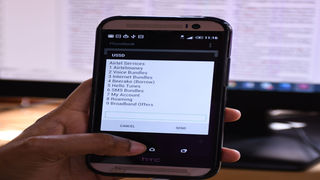
A customer buys data. According to the Uganda Communications Commission, only 10 million out of 34 million mobile phone subscribers own smartphones, meaning the country’s smartphone penetration stood at approximately 29.4 percent as of the end of last year. PHOTO/ EDGAR R. BATTE
|Prosper
Prime
Why are Internet costs high?
What you need to know:
- Government’s decision to impose18 percent VAT and 12 percent excise duty on mobile phones, in addition to a raft of other levies and taxes on the Internet, is expected to keep the price of the Internet high.
Uganda’s Internet users have more than quadrupled from 5 million to approximately 24 million in the last 10 years, mainly driven by the telecommunication industry’s increasing investment in network coverage and the growing demand for digital services.
Ironically, the cost of internet access has remained high within the same period, prompting policymakers (members of Parliament) to ask Uganda Communication Commission, the industry regulator, to moderate the prices.
However, UCC and the telecommunication companies – mainly MTN, Airtel, and UTL – are in a dilemma mainly caused by low Internet usage, especially through smartphones, and high operational and infrastructural costs compared to the rest of the countries in East Africa.
A comparative analysis of the telecommunication environment and ecosystems in the region may explain this. Independent research shows that Uganda is ranked third in smartphone penetration in the region, behind Tanzania and Kenya, signifying low usage and consequently, the potential that exists if more effort is put to make smartphones more accessible to the population.
According to the Uganda Communications Commission, only 10 million out of the 34 million mobile phone subscribers own smartphones, meaning the country’s smartphone penetration stood at approximately 29.4 percent as of the end of last year.
This implies that Internet usage is only heavy within the formal businesses and company’s environment, leaving a huge under-served market of individual and informal businesses.
It is these markets that the other countries in the region have sought to address by rationalising taxes both Internet access (data) and the cost of devices (Smartphones).
Tanzania and Kenya’s smartphone penetration stood at 38 percent and 53 percent, respectively.
Tanzania waived Value Added Tax (VAT) on smartphones, tablets, and modems in the Financial Year 2021-2022 as part of a plan to bring broadband penetration to 80 percent by 2025. But the waiver was removed in the Financial Year 2022-2023 on the assertion that it did not achieve the intended purpose.
Kenya waived the VAT on mobile handsets in 2009, enabling most of the population, especially those in the lower pyramid to own smartphones.
Statistics from the Communication Authority of Kenya show that one out of two Kenyans owned a smartphone as at the end of September last year. This huge increase in smartphone penetration and subsequently digital services has, however, encouraged government to tap into this growing segment.
Kenya’s case
This year, the Kenyan government imposed a 10 percent excise duty on each mobile phone imported into the country in addition to Sh50 excise duty on every imported ready-to-use SIM card as a measure to tap revenue from the maturing internet market.
Rwanda and Burundi have the lowest smartphone penetration of 15 percent and 10 percent, respectively.
However, the Rwandan government scrapped import duty and VAT on mobile phones in 2012 and 2015, respectively, to speed up smartphone ownership and support the government’s ambition to digitise the economy.
Heavy investments vs low users
Uganda’s low internet users coupled with limited deliberate policies to reverse this trend has remained a concern to various stakeholders including telecom players.
Enid Edroma, the general manager, corporate affairs at MTN, said although the telecom industry is investing heavily in the infrastructure to boost Internet services to the customers, the low users have limited their ability to generate enough revenue that can minimise operational costs and lower the Internet prices.

Uganda’s low internet users coupled with limited deliberate policies to reverse this trend has remained a concern to various stakeholders including telecom players. PHOTO/ ISAAC KASAMANI
“Currently, only 35 percent of our customers are using smartphones. We are also using only five percent of our underground Internet cables yet the operational costs remain the same,” she said, adding that an increase in Internet users will drive down the price of Internet and eventually stimulate digital activities.
Edroma said the government’s decision to impose18 percent VAT and 12 percent excise duty on mobile phones, in addition to a raft of other levies and taxes on the Internet, is expected to keep the price of the Internet high, slowing down smartphone penetration and contribution to the general economy.
Analysis by the country’s telecom industry shows that a new low-cost smartphone priced at Shs179,782 in China attracts levies and duties of up 33 percent, translating into approximately Shs59,554 in Uganda. This includes a 2 percent local clearance fee that eventually translates into Shs3,596, a 1.50 percent infrastructural levy into Shs2,537, and a 10 percent import duty into Shs16, 912.
Other taxes include; 18 percent VAT which translates into Shs36,509 and a 10 percent average retail commission which translates into Shs23,934. This makes the smartphone device on arrival on the Ugandan market priced at an average of Shs263,269.
Uganda also has high operational and infrastructural costs to deliver mobile Internet services compared to the neighbouring countries. The industry players argue that Uganda being a land-locked country incurs significantly higher costs to get capacity from the sea through Kenya and Tanzania, which when factored into the end user prices, becomes expensive to customers compared to their counterparts in Kenya and Tanzania.
For instance, the telecommunication industry indicates that Shs5,000 for 1GB of Internet attracts an18 percent VAT which translates into Shs900, and 12 percent excise duty which translates into Shs600. These two taxes combined attract Shs1,500 as taxes yet the production cost for 1GB of the Internet is Shs3,000. This leaves the telecom company with a profit of Shs500, an amount that is too low to sustain the company’s operation.
Industry experts on tax and other matters say the government is caught between a rock and a hard place in trying to balance enhancing investments in ICT and mobilising revenue to deliver services to its population.
“The best option for telecoms is to provide evidence that indeed taxes on handsets are hampering reduction in Internet prices,” said Dr Fred Muhumuza, an economist at Makerere University.
Dr Muhumuza added that although taxes on mobile phones could have a negative impact on new owners, the existing customers are likely to remain hooked on the Internet, possibly due to the nature of their work, or simply an addiction to online activities.
Edrine Wanyama, the legal officer at Collaboration on International ICT Policy for East and Southern Africa (CIPESA) states in her policy brief dubbed: ‘Taxing Ugandan Citizens out of the Digital Society,’ that there is a need for government to reduce import duty on ICT devices as well as the excise duty on airtime and value-added services by 50 percent, lower VAT on ICT services from the current 18 percent to not more than 12 percent and repeal the 12 percent levy on the Internet.
“This multiple taxation translates into the high cost of services, devices, hardware, and software, with suppliers and service providers passing on the financial burden onto consumers, thereby aggravating the affordability challenge,” she said.
Possible solutions
Meanwhile, the telecommunication industry is looking for alternatives to bring down the price of Internet.
For instance, MTN has partnered with Original End Manufacturers (OEMs) and as smartphone dealers to subsidise the cost of low-end smartphones that can attract first-time users into the data market.
Despite all these initiatives, Edroma says to support telecommunications industry and make Internet services more affordable to customers, the government should reduce import duties on smartphones to lower overall prices for prospective customers, especially those in rural areas.
“There is also a need to assign more spectrum to telecom companies such as MTN Uganda to support a new technology that we intend to deploy to create efficiencies in the delivery of services to customers and which will easily translate into a reduction of cost in operations and prices,” she said.
“More electrification of the rural areas is needed to support the telecom towers installed in those areas and reduce the cost of running off fuel generators which will result in reduced cost of operations and benefits to consumers in terms of prices.”
She said implementing some of the proposed initiatives will drive down the prices of the Internet for the benefit of the population and business, stimulating the country’s growth and development.
Government initiatives
Mid-last month, State Minister for Information and Communication Technologies, Joyce Nabbosa Ssebugwawo, said the government is working with partners to achieve seamless Internet connectivity that will drive down the price of Internet.
“We are working with partners towards seamless Internet connectivity and affordability of Internet data,” she said during the Fintech Landscape Exhibition, noting that affordable Internet has partly been achieved even as more still needs to be done.




